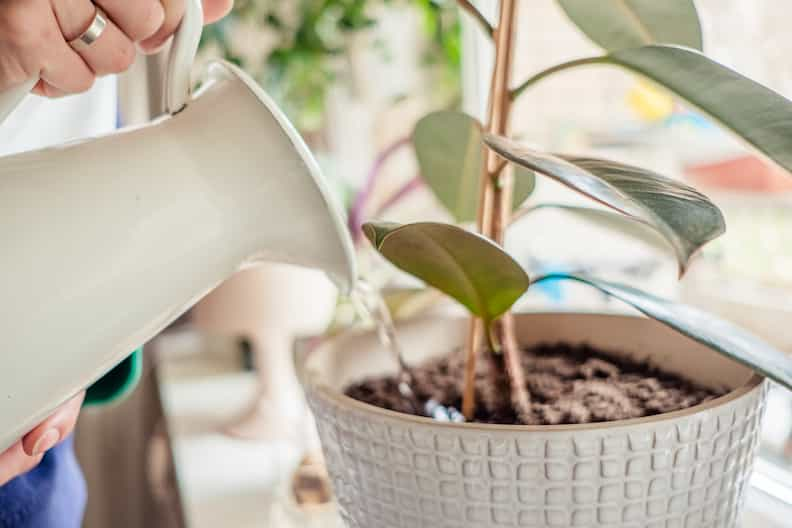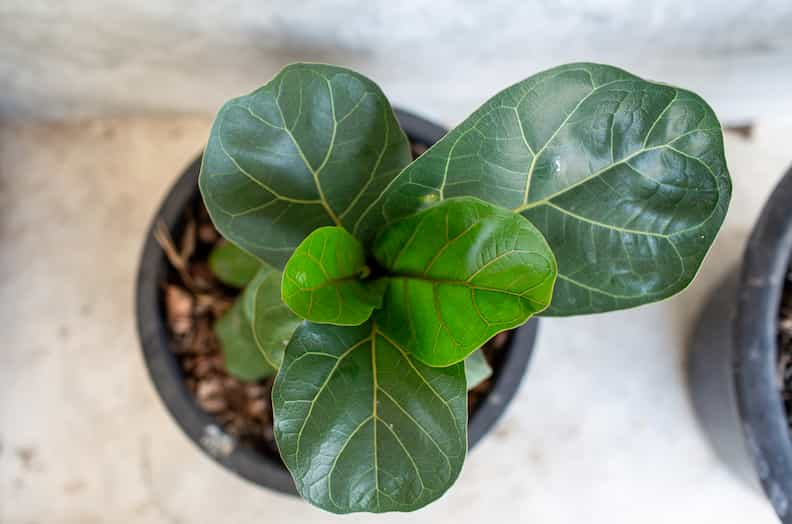It’s heartbreaking when a beloved houseplant dies. But is it possible to bring it back to life?
Keep reading as we explore the possibility of reviving a dead fiddle leaf fig – including our tips on just how to do this!

Table of Contents
Can a dead fiddle leaf fig come back?
The only way to revive a “Dead” fiddle leaf plant is if at least a part of the main stem is still alive. If the center stem is mushy or black, it is most likely dead and gone for good. If the stem is still green and pliable, there may be a chance to save your plant!
If there is a severe fungal, bacterial, or pest infestation, it is best to throw out the plant and start fresh. These problems can spread quickly to your other plants and be difficult to eliminate.
Extreme dryness may also be hard to recover from. If the leaves are crispy and brown, they will not green up again.
Finally, if your plant doesn’t have any leaves on it, like if your fiddle leaf fig’s leaves have fallen off, it may be too much work to revive it. This is because the plant needs leaves to go through photosynthesis. If your fiddle leaf fig has no leaves, the plant can’t make its own food and will eventually die.
If the above conditions are mild to moderate or you see other signs of stress on your fiddle leaf fig, there may be a chance that the plant can come back. Let’s dive into ways that you can help recover your fiddle leaf fig so it can live to see another day.
How do you revive an almost dead fiddle leaf fig?
1. Prune your fiddle leaf fig leaves
The first step is to prune any dead or dying leaves. This will help the plant focus its energy on the healthy parts of the plant. It will also help to remove any pests that may be hiding on the leaves.
When pruning a fiddle leaf fig, use sharp, clean scissors or shears to cut off the leaves at the base of the stem. If there are any brown or yellow leaves, you can remove those as well. Be sure to dispose of the dead leaves so the pests don’t spread to your other plants.

2. Prune your fiddle leaf fig branches
Now, check the branches of your plant for signs of weakness or disease. If any of them are dead, wilting, or extremely discolored, you will need to prune them as well.
Don’t worry about necessarily pruning branches that are bare. There are usually buds within the leaf axils that will grow into new leaves on your fiddle leaf fig over time.
3. Treat your fiddle leaf fig for pests
Next, you’ll want to make sure that any pests or microbial infections are wiped out. Use neem oil mixed with water to create a spray. You can also use horticultural oil or insecticidal soap.
Be sure to follow the instructions on the product you’re using. You don’t want to accidentally harm your plant by using too much of the product.

4. Check your fiddle leaf fig’s roots
Now you will check the roots of your plant. If they are mushy or black, you will need to cut them off. Be sure to cut an inch or two above the mushy part so you completely remove the rot.
Find out more: How to Fix Root Rot in Your Fiddle Leaf Fig
5. Change the soil or pot if necessary
Now that you’ve refreshed the roots, it’s important to put them in fresh healthy soil. This will remove any of the pests or pathogens that may be lingering as well as provide the fiddle leaf fig with fresh nutrients.
There are specific soils that are best for fiddle leaf fig plants. You can also use a tropical potting mix. If the roots are tight in the pot, increase the pot size by one or two inches. Don’t increase the pot size too much, as this could lead to root rot.
6. Provide your fiddle leaf fig with plenty of light and water
Once you’ve made sure that your plant is trimmed, treated, and has fresh soil, it’s time to give it plenty of light and water. Fiddle leaf figs need light, specifically, they like approximately 6 hours of bright direct sun each day, which will help to stimulate growth.
Water your plant thoroughly and then allow the soil to dry out completely before watering again. It’s better to underwater a fiddle leaf fig than overwater it, as this can lead to root rot. Use your finger to test the soil to determine when it is best to water your plant.
Related: 5 Easy Steps to Save an Overwatered Fiddle Leaf Fig
7. Notch your fiddle leaf to encourage new growth
If your plant is still looking a bit sparse, you can encourage new growth by notching your fiddle leaf fig. This means that you will make a small cut in the stem with a sharp knife. This stimulates the hormones in the plant that encourage growth.
Make sure that you sterilize the knife before making the cut. You don’t want to introduce any new pathogens or pests to your plant. Cut about an inch below a leaf node, which is where the leaves attach to the stem. Don’t fully cut through the stem, simply create a small indent that a new bud can grow from.

8. Trim new growth to encourage further branching
When new growth finally appears on your plant, you will want to trim it. This may seem counterintuitive, but it actually encourages the plant to branch out.
As always, use a clean pair of scissors and make a clean cut in order to avoid damaging the plant. Cut just above a leaf node, which is where the leaves attach to the stem.
How do you know when a fiddle leaf fig is dying?
There are plenty of tell-tale signs that a fiddle leaf fig is unhealthy or dying. Here are some of the most common signs:
1. The leaves are wilting, yellowing, or falling off
One of the most common signs that a fiddle leaf fig is dying is when your fiddle leaf fig’s leaves start to droop, turn yellow, or fall off. This can be a sign of too much or too little water, as well as a lack of nutrients.
If you see this happening, check the roots and soil of your plant. If the roots are mushy or black, you will need to cut them off. Be sure to cut an inch or two above the mushy part so you completely remove the rot.
Related: 5 Ways to Fix a Fiddle Leaf Fig With Yellow Leaves
2. The plant is not growing new leaves
Another sign that your plant is unhealthy is if your fiddle leaf fig stops growing new leaves. This can be a sign of too little light, so make sure that your plant is getting at least six hours of bright direct sunlight each day.
It can also be a sign of poor nutrition, so make sure that you are fertilizing your plant regularly.

3. The stem is soft or mushy
If the stem of your fiddle leaf fig is soft or mushy, this is a sign of root rot. Root rot is caused by too much water and can quickly kill a plant. In addition to treating the plant’s roots, you will want to thicken up your fiddle leaf fig’s stem by regularly shaking it or directing a fan towards it.
Another way to limit root rot is to make sure your pot and soil can drain properly. Be sure to check the drainage holes in the pot and bottom of the plant to make sure they are not blocked. Consider adding rocks, perlite, or charcoal to the bottom of the pot to improve drainage.
4. There are black or brown spots on the leaves
If you see black or brown spots on the leaves of your fiddle leaf fig, this is a sign of a fungal infection. Fungal infections are often caused by too much moisture.
Treat your plant with a fungicide and make sure to keep the leaves dry. You may also need to trim off any affected leaves.
5. The plant has pests or an infection
If you see pests on your fiddle leaf fig or notice that the leaves are discolored or have strange markings, this is a sign of an infection. Infections can be caused by pests such as mealybugs, aphids, or scale.
Treat your plant with an insecticide and make sure to remove any affected leaves. You may also need to quarantine your plant to prevent the infection from spreading.
Should I cut dead leaves off a fiddle leaf fig?
Yes, you should cut dead leaves off a fiddle leaf fig. Dead leaves can harbor pests and diseases, which can infect the rest of the plant. They can also prevent the plant from receiving the nutrients it needs and may result in the plant not absorbing enough energy.
You can also cut off dying leaves before they are completely dead. This can help to redirect energy to healthier and newer sections of your fiddle leaf fig.
Try to cut at the internodal junction, which is the point where the leaf attaches to the stem. This will help to prevent damage to the plant and encourage new growth.
